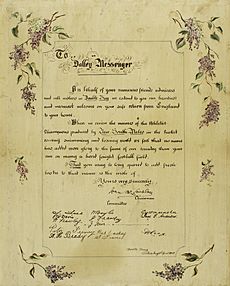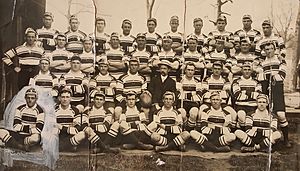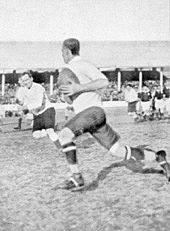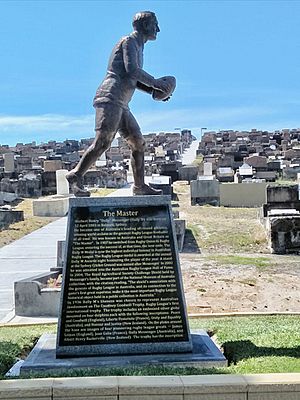Dally Messenger facts for kids
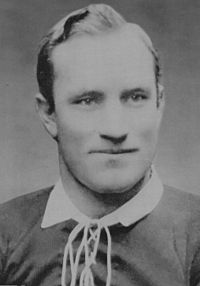
Messenger in 1907
|
|||||||||||||||||||||||||||||||||||||||||||||||||||||||||||||||||||||||
|
Personal information
|
|||||||||||||||||||||||||||||||||||||||||||||||||||||||||||||||||||||||
|---|---|---|---|---|---|---|---|---|---|---|---|---|---|---|---|---|---|---|---|---|---|---|---|---|---|---|---|---|---|---|---|---|---|---|---|---|---|---|---|---|---|---|---|---|---|---|---|---|---|---|---|---|---|---|---|---|---|---|---|---|---|---|---|---|---|---|---|---|---|---|---|
| Full name | Herbert Henry Messenger | ||||||||||||||||||||||||||||||||||||||||||||||||||||||||||||||||||||||
| Born | 12 April 1883 Balmain, New South Wales |
||||||||||||||||||||||||||||||||||||||||||||||||||||||||||||||||||||||
| Died | 24 November 1959 (aged 76) Gunnedah, New South Wales |
||||||||||||||||||||||||||||||||||||||||||||||||||||||||||||||||||||||
|
Playing information
|
|||||||||||||||||||||||||||||||||||||||||||||||||||||||||||||||||||||||
| Height | 5 ft 7.5 in (171.5 cm) | ||||||||||||||||||||||||||||||||||||||||||||||||||||||||||||||||||||||
| Weight | 12 st (76 kg) | ||||||||||||||||||||||||||||||||||||||||||||||||||||||||||||||||||||||
|
Rugby union
|
|||||||||||||||||||||||||||||||||||||||||||||||||||||||||||||||||||||||
| Position | Wing, First five-eighth, Centre | ||||||||||||||||||||||||||||||||||||||||||||||||||||||||||||||||||||||
|
|||||||||||||||||||||||||||||||||||||||||||||||||||||||||||||||||||||||
|
Rugby league
|
|||||||||||||||||||||||||||||||||||||||||||||||||||||||||||||||||||||||
| Position | Centre | ||||||||||||||||||||||||||||||||||||||||||||||||||||||||||||||||||||||
|
|||||||||||||||||||||||||||||||||||||||||||||||||||||||||||||||||||||||
Herbert Henry Messenger, known as "Dally" and sometimes "The Master", was born on April 12, 1883, and passed away on November 24, 1959. He was one of Australia's first professional rugby football players. Many people consider him one of the best players ever in both rugby codes. He played for New South Wales in the very first game of the new New South Wales Rugby Football League. This league had just separated from the older New South Wales Rugby Football Union.
Dally Messenger was strong and well-built. Even though he was about 172 cm (5 ft 7.5 in) tall, he was a powerful runner. He was also a very good defender. People who played with him said he was hard to predict. He had amazing body control and could kick goals from almost anywhere on the field. During his career, he rarely ate before a game, except for breakfast.
Contents
Early Life and Nickname
Messenger was born in Balmain, New South Wales, a suburb by the water in Sydney. He grew up in Double Bay, another waterfront suburb. His father, Charles Amos Messenger, was a champion rower who owned a boat shed. Dally also lived for a while with his aunt in South Melbourne, Victoria. There, he went to Albert Park Public School. He remembered playing Victorian rules football there. He believed the skills he learned at Albert Park helped him later in rugby.
Dally was one of eight children. His younger brother, Walter (Wally), also became a famous Australian footballer. In Sydney, Dally went to Double Bay Public School. Here, he improved his rugby skills. He also enjoyed cricket and his other favorite sport, sailing. Messenger also worked at his father's boat shed. He got the nickname "Dally" when he was a small child. It came from a politician in the 1880s, William Bede Dalley. This politician was known for his large stomach, which young Herbert Henry also had. Luckily, Dally lost his "pot belly" as he grew up, and the "e" was dropped from his nickname.
Starting in Rugby Union
Dally Messenger started playing competitive rugby in 1900. He played for a local rugby union club called the Warrigals. For a few years, he kept playing with the Warrigals. He kept saying no to offers from Eastern Suburbs RUFC to play in Sydney's higher-level competition. In 1904, when he was 21, Messenger took a break from football. He spent that year working for his family's boatbuilding business.
In 1905, Messenger began playing for Easts in their second-grade team. He showed so much talent that he played for the first-grade team twice that season. He also reportedly played some first-grade Australian rules football games in Sydney that same year.
Messenger started the 1906 season in first grade with Easts as a 'standoff' (five-eighth). Fans quickly loved him for his amazing ball skills, clever tricks, incredible speed, and accurate kicking. He could kick with either foot. Messenger then moved to his usual position of centre. He was chosen for this spot in the New South Wales team in 1906. By the time he played for the Wallabies in 1907, he was known as the best centre.
A player from 1906, Paddy Moran, wrote that Messenger's play was "full of surprises." He said Dally was "unorthodox" and "flashy." Moran explained that Messenger "never became a slave to copybook practices." This meant he didn't just follow the rules. Instead, his natural talent helped him see and take chances very quickly. Moran compared him to the famous cricketer Donald Bradman. Both could instantly get their bodies into the right position just as the ball arrived.
When people started talking about a professional rugby competition, called Rugby League, Messenger was very interested. A group, including cricketer Victor Trumper and his friend J. J. Giltinan, approached him. They knew that getting Messenger to join would be a huge boost for the new sport. He signed up with the new professional code on August 11, 1907. Since he was the top rugby player at the time, Messenger's decision was key to starting rugby league. After he became a professional rugby league player, his rugby union games were removed from the records. They were not put back for 100 years.
Rugby League with the NZ All Blacks-"All Golds" 1907-08
Messenger played in the special series against a professional New Zealand team. This team was called the 'All Golds'. He was then invited to tour England with this New Zealand professional team. It's not fully clear if this was because of how well he played or if it was part of his deal to join the new sport. It was said, and believed by the Messenger family for years, that Dally's mother, Annie, helped arrange his move to rugby league. The payment for playing in the first three All Golds' games was 50 pounds. This amount would be worth a lot more money today.
It was in the North of England that Messenger learned more about the new game. By the end of the tour, Messenger had scored more points than anyone else. He was over 100 points ahead of the next player.
The 1908 Inaugural Rugby League Season
When he returned to Australia, Messenger played for the Eastern Suburbs club. This club was part of the new New South Wales Rugby Football League (NSWRFL). However, he played only a few games for his club. This was because he had a very busy schedule playing for representative teams. Messenger's popularity helped make the new game famous. The NSWRFL used this to their advantage.
He was chosen to play in the first ever trans-Tasman test. This was the very first game for the Australia national rugby league team. In rugby league's first year, Messenger played for many teams. Besides his club, he played for Metropolis (Sydney), New South Wales, and Australia. He also played for New Zealand and, in one game, for Queensland. He even represented Australasia.
After two big losses, Messenger agreed to play for Queensland in a third game against New Zealand. That game ended in a 22–22 tie. Messenger scored nine of Queensland's 22 points.
The 1908 Interstate rugby league series saw the first game between New South Wales and Queensland. Messenger scored a goal for New South Wales in their 43-0 win over Queensland in Sydney. During the 1908 New Zealand Māori rugby league tour of Australia, Messenger was chosen to play for New South Wales and Sydney against the touring team.
The Pioneer Kangaroos 1908-1909
Near the end of the 1908 season, Messenger was again chosen to tour England. This time, it was with the first Kangaroos, also known as the 'Pioneers'. He is listed as Kangaroo No. 10 on the Australian Players Register.
Having toured with the New Zealand professional team the year before, Messenger was already famous in the North of England. When he arrived, he became a celebrity. Signs saying 'Messenger Will Play' were put up outside stadiums. Leading soccer clubs, like Glasgow Celtic, Newcastle United, and Tottenham Hotspur, offered Messenger contracts. But he turned them down.
Messenger was the captain for Australia in the first two test matches of the tour. He missed the third game because of a knee injury. This injury happened after he tried many field goals. On the tour, Messenger was known for scoring many goals from far away. One kick from his own 25-yard line, near the sideline, was once in the 'Guinness Book of World Records'. It was said to be over 80 yards (73m) long. Another kick from over 75 yards was mentioned in an English newspaper as 'A Wonderful Kick'.
In the second test match, Messenger scored one of the greatest individual tries ever seen in Test rugby league. By the end of the tour, Messenger had once again scored the most points. He was almost 100 points ahead of the next player.
Club Seasons 1909-1913
After returning home from the tour, Messenger was injured and had played a lot of games. So, he decided to sit out most of the 1909 NSWRFL season. He only played in a few representative games near the end of the year. Messenger also said no to an offer to play with the English club Warrington during Australia's off-season. Messenger was captain of Australia when they played against the 1910 Great Britain Lions tourists.
The 1911 season is often called Messenger's best. In 21 games, he scored a record 270 points. In one game for New South Wales, he scored 32 points. This came from four tries and 10 goals. That record has only been matched in recent years, but now tries are worth 4 points instead of 3. He scored a total of 72 points in that three-game series.
Messenger had recently gotten married. He decided not to go on the 1911–12 Kangaroo tour of Great Britain. Instead, he led his club, Eastern Suburbs, to their first championship. In the semi-final that year against South Sydney, Messenger scored 20 of Easts' 23 points. For three years in a row, 1910, 1911, and 1912, he was the NSWRFL's top point scorer. In 1911, he broke Arthur Conlin's record for most points scored in an NSWRFL career (101). Messenger's total of 379 points was the new career record until Harold Horder broke it in 1918.
After he stopped playing representative football, he led his team to a second championship in 1912. Then, they won a third championship in a row in 1913. Easts were given permanent possession of the NSWRFL's first trophy, the Royal Agricultural Society Shield. When Messenger announced his retirement, the Eastern Suburbs club gave him the shield to show their thanks.
He was given Life Membership of the New South Wales Rugby League in 1914.
Life After Football
Besides his rugby skills, Messenger was also a talented cricketer, canoeist, and sailor. After his rugby league career ended, he managed a few hotels in Sydney and Manilla, New South Wales. He also ran a banana plantation in Mount Buderim, Queensland. Later, he worked as a carpenter for the NSW Department of Public Works.
In his later years, he lived in the New South Wales Rugby League's club in Phillip Street. The news reported that Messenger had a heart attack on November 18, 1959. He passed away in Gunnedah six days later. His body was brought back to Sydney for a large funeral. He was buried on November 26, 1959, at the Eastern Suburbs Memorial Park.
Accolades and Legacy
The Courtney Goodwill Trophy was international rugby league's first trophy. It was first given out in 1936. The trophy showed Messenger along with three other great players: Jean Galia (France), Albert Baskiville (New Zealand), and James Lomas (Britain).
The Dally M. Medal is given out every year to Australia's best rugby league player. Expert commentators vote, and their votes are counted at the end of each season. A stand at the Sydney Cricket Ground was also named after Messenger. This was to honor his many great games for his club and representative teams. In 2003, he was added to the Australian Rugby League Hall of Fame.
In 2004, the Royal Agricultural Society Shield, which Messenger's family owned, became part of the National Museum of Australia collection.
In 2007, 100 years after he was rejected by rugby union for switching to rugby league, his playing record was officially put back.
In February 2008, Messenger was named in a list of Australia's 100 greatest players (1908–2007). This list was created by the NRL / ARL to celebrate 100 years of the sport in Australia. Messenger was later named as an interchange player in Australian rugby league's Team of the Century. This team was chosen on April 17, 2008, by a panel of selectors.
In 2008, New South Wales also announced their rugby league team of the century. Messenger was named on the wing. However, if he were playing today, he would likely play as a halfback (scrum-half). This is because players are much bigger now.
Messenger was honored in 2008 with a life-size bronze statue. Artist Cathy Weiszmann created it, and it stands outside the Sydney Football Stadium. This statue is the second in a planned series of 10 sculptures for the Sydney Cricket Ground Trust's Basil Sellers Sports Sculptures Project.
In 2018, Messenger was inducted as a Rugby League Immortal. He joined other famous players from before WWII, like Dave Brown and Frank Burge. More recent greats, Norm Provan and Mal Meninga, were also inducted at the same time.




